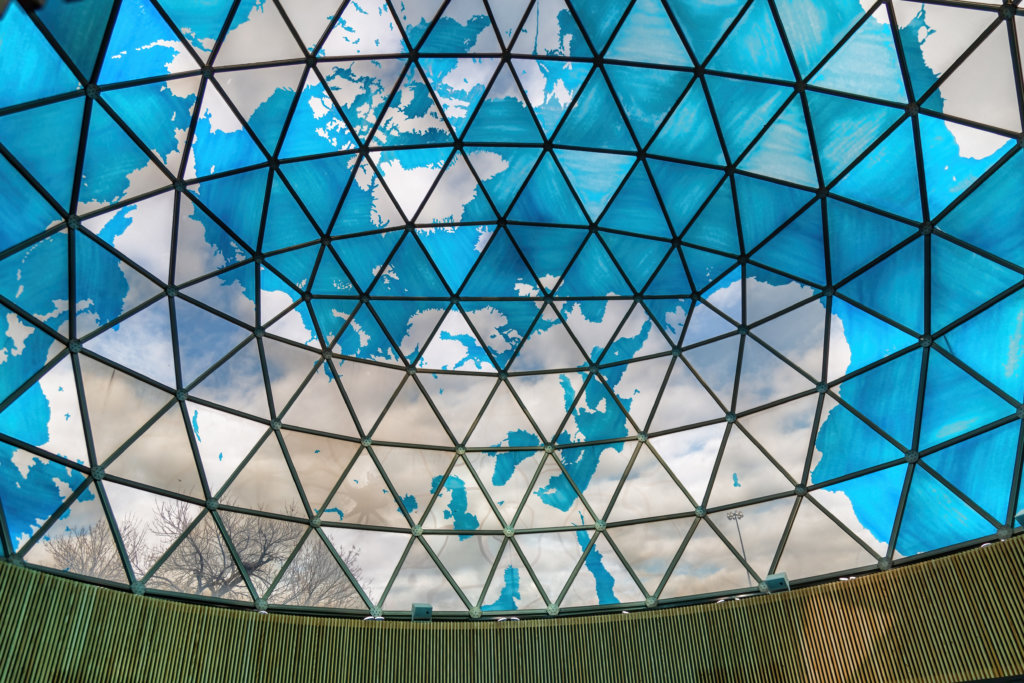
The Center for Spirituality & Sustainability (originally called the Religious Center) at the Edwardsville campus of Southern Illinois University isn’t just any building: it is a surveyor-certified, mathematically exact, transparent miniature Earth[1].
Built between 1970-71 by architect Shoji Sadao in partnership with famed architect, futurist, inventor, and author, Buckminster Fuller, it was envisioned as a meeting point for the world’s cultural and spiritual traditions, connecting them through their common concern for the planet[2].
The building straddles the 90th western meridian, which happens to run through Edwardsville. Fuller used this line to redraw the map of the world, using it as traditional mapmakers use the Equator.
His map, known as the Dymaxion Map, appears on the ceiling of the dome, the entire world oriented around Edwardsville.

The Fuller Dome, Photo by Mike Matney 2021
Standing at its center looking up, “our planet’s continents can be seen accurately outlined against the transparent blue oceans as they would be seen by X-rays if one descended by elevator from Edwardsville to the center of the real earth,” Fuller explained in Geoview, his essay on the dome[3].
When looking through the glass to the sky, you can picture how the stars shining in each location on the map are the same star fields that would appear directly overhead in the night sky in that part of the world.
In other words, inside this dome, you can see not only your place in the world but the world’s place in the universe. As Fuller himself poetically stated, “One goes inside to go outside one’s self and into the center of the Earth and thence outward to the stars.”
When the campus was built in the 1960s, a religious council made up of several local pastors, ministers, and preachers came together to plan a space for students to worship. The architects who designed the rest of the campus got to work, and the council began fundraising to meet the $500,000 price tag for construction.
Sadly, they fell short—about $250,000 short. When the council began to seek other options, the university’s president recommended another faculty member who might be able to help[4].
Fuller was the patent holder for the geodesic dome, a design for a lattice-celled structure made up of dozens or hundreds of smaller triangles. The dome could withstand considerable structural loads and could be built quickly and inexpensively.
Through the ’50s and ’60s, Fuller designed several of them in cities across the United States, including his home in Carbondale, another SIU campus where he was teaching at the time[5]. Thanks to the unique design, Fuller and Sadao could build a dome for the Edwardsville campus that met the council’s specifications at half the cost[6].
The structural benefits of the geodesic dome remain sound even today, and it is still frequently used for lightweight tents, as well as semi-permanent research outposts, often built from 3D printed designs and materials.
Countless other domes continued to be raised in the ensuing decades, like the Missouri Botanical Garden’s Climatron (named in 1976 as one of the 100 most significant architectural achievements in U.S. history), and some as far away as Antarctica.
The dome at SIU remains perhaps the most ambitious of all the domes Fuller ever built. It is the first of only two that were personally conceived, designed, and built by Fuller, in conjunction with his architect partner Shoji Sadao. Through it, Fuller hoped to give its visitors a way to transcend their limited perspective, to see the great interconnectedness of every population and belief system bound to our precious blue orb.
“The Edwardsville religious center becomes at once the cathedral of universal reality and cathedral of universal mystery,” he wrote.
References
[1] https://www.fullerdome.org/the-dome
[2] https://www.siue.edu/religion/
[3] https://www.siue.edu/religion/pdf/Geoview_by_Fuller.pdf
[4] https://madison-historical.siue.edu/encyclopedia/siue-fuller-dome/
[5] https://www.youtube.com/watch?v=E98Zh4XjcJ0&t=700s
[6] https://madison-historical.siue.edu/encyclopedia/siue-fuller-dome/